| |
Pure Software code |
|
| |
Lebanon  | |
|
 |
|
Solar
Energy & Gas Studies |
| |
|
| |
 |
| Home :
Solar Energy & Gas Studies |

| | |
| |
| |
|
the Titles ... |
|
|
| |
 |
Les Titres, en
Français
: | |
|
| |
| |
 |
العناويين باللغة العربية
: | |
|
| |
|
| |
|
|
|
|
| |
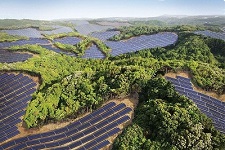 |
|
Photovoltaic
Solar
Power Farm | | |
|
| |
|
|
1- Solar
Power Systems |
|
- Solar panel systems
(also known as solar photovoltaics or solar
PV) convert the sun’s energy into electricity.
- Concentrated solar power
(also called concentrating solar power,
concentrated solar thermal, and CSP) systems
generate solar power by using mirrors or lenses to
concentrate a large area of sunlight, or solar thermal
energy, onto a small area.
- Solar thermal energy
(STE) is a form of energy and a technology for
harnessing solar energy to generate thermal energy or
electrical energy for use in industry, and in the
residential and commercial sectors.
|
|
|
|
| |
1.1-
Download Study in 4 Parts, Solar
Energy Power Systems, in English |
|
|
|
This Study Consists of 4 Parts,
in English :
|
|
|
| |
|
|
1.1- Solar Energy
Systems, Introduction |
(0.5 MB zip file)
download
|
-
Solar Power Home System, for
Home
applications
-
Determine the Sizing of Solar
PV
system, Inverter, Battery,
-
Gallery, Solar Power
Systems
|
-
Current Solar
Technologies
-
Parabolic Trough
-
Solar Power Tower
-
Fresnel Reflector
-
Dish Stirling/Engine
-
Enclosed
Trough
|
|
-
List of Solar Power
Stations
-
Operational Solar
Thermal
Power Stations
-
Solar Thermal Power
Stations under
construction
-
Solar Thermal Power
Stations, in Other
Countries
| |
-
Gallery, Solar Water
Heating
-
Thermosiphon /
Thermosyphon
-
Solar Water Heating
-
Types of Solar Heating
Systems
-
Types of Solar
Collectors
|
| |
 |
|
Photovoltaic
Solar
Power
Home |
| |
| |
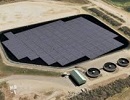 |
|
Floating Photovoltaic
Solar
Power
Station |
| |
| |
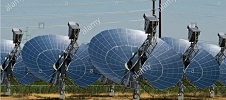 |
|
Solar Dish Power
Station | | | |
|
|
| |
|
More
Information about this Study - Plan, Data, Size
& ...
|
-
Solar
Energy Systems Study Consists of 4 Parts
-
Technologies, Plans, Data,
References, Information,
Pictures, Galleries,
...
- English Text,
Html document =
203 Files and 5
Folder and 149 photos
-
Size of Study =Size of 4 Parts of this
Study = 0.5 MB Zip file + 1.5 MB Zip
file+3.3 MB Zip file + 0.56 MB Zip file = 5.86
or 6 MB zip file
|
|
|
|
| | | |
|
| |
| |
|
|
|
1.2-
Solar
Power System for
home residential
applications, in English | |
|
|
| |
| The
Design of this Solar Electrical
System :
>>>>> |
- Input
Source
components:
- Solar
Panels - converts
sunlight into
DC electricity
-
Auxiliary energy
sources: Ac
grid input, diesel
generator
or other renewable
energy sources
- battery bank
- stores energy
for supplying to
electrical appliances when there
is a
demand
|
- Controller
+ Inverter:
controller
– regulates the
voltage and current coming
from the
Solar panels ..., Inverter
– converts DC panels
into a clean AC
..
- Output
Source:
electrical appliances - such as lights,
radio, TV, computer, refrigerat or, etc
|
|
|
|
|
|
Click on the
pictures to enlarge this Design |
|
|
|
|
| | |
|
| |
| |
|
|
1.3-
Solar power system components, in English: |
|
Solar PV system includes different components that
should be selected according to your system type, site location and
applications. The major components for solar PV system are solar charge
controller, inverter, battery bank, auxiliary energy sources and loads
(appliances).
- PV module –
converts sunlight into DC electricity.
-
Solar charge controller – regulates the voltage and
current coming from the PV panels going to battery and prevents battery
overcharging and prolongs the battery life.
Battery – stores energy for supplying to electrical
appliances when there is a demand
-
Inverter – converts DC output of PV panels or wind
turbine into a clean AC current for AC appliances or fed back into grid
line.
- Load – is electrical appliances that
connected to solar PV system such as lights, radio, TV, computer,
refrigerator, etc.
- Auxiliary energy
sources - is diesel generator or other renewable energy
sources.
|
|
|
|
|
|
| |
| |
 |
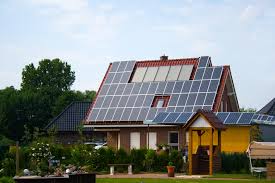 |
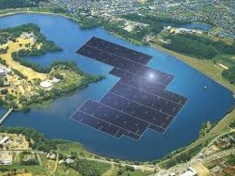 |
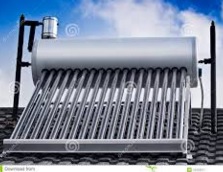 |
|
Photovoltaic Solar Power
Farm in USA, Station |
Photovoltaic
Solar
Power
Home |
Photovoltaic Floating Solar Power System,
Station |
Solar Water Heating System |
|
| |
| |
|
|
1.4- Design &
Determine the Sizing of Solar PV system, Inverter, Battery,
... OR How to Design Solar PV System?
|
|
|
1. Determine power consumption demands
The first step in
designing a solar PV system is to find out the total power and energy
consumption of all loads that need to be supplied by the solar PV system
as follows:
1.1 Calculate total Watt-hours per day
for each appliance
used.
Add the Watt-hours needed for all appliances together to get the total
Watt-hours per day which must be delivered to the
appliances.
1.2 Calculate total
Watt-hours per day needed from the PV
modules.
Multiply the total appliances Watt-hours per
day times 1.3 (the energy lost in the system) to get the total
Watt-hours per day which must be provided by the panels.
2. Size the PV modules
Different size of PV
modules will produce different amount of power. To find out the sizing of
PV module, the total peak watt produced needs. The peak watt (Wp) produced depends on size of the PV
module and climate of site location. We have to consider “panel generation
factor” which is different in each site location. For Thailand, the panel generation factor is
3.43. To determine the sizing of PV modules, calculate as
follows:
2.1 Calculate the total
Watt-peak rating needed for PV
modules
Divide the total Watt-hours per day needed from the PV modules (from
item 1.2) by 3.43 to
get the total Watt-peak rating needed for the PV panels needed
to operate the appliances.
2.2 Calculate the number of
PV panels for the
system
Divide the answer obtained in item 2.1 by the rated output Watt-peak of
the PV modules available to you. Increase any fractional part of result to
the next highest full number and that will be the
number of
PV modules required.
Result of the calculation is the minimum
number of PV panels. If more PV modules are installed, the system will
perform better and battery life will be improved. If fewer PV modules are
used, the system may not work at all during cloudy periods and battery
life will be shortened.
3. Inverter sizing
An inverter is used in
the system where AC power output is needed. The input rating of the
inverter should never be lower than the total watt of appliances. The
inverter must have the same nominal voltage as your battery.
For stand-alone
systems, the inverter must be large enough to handle the total amount of
Watts you will be using at one time. The inverter size should be 25-30%
bigger than total Watts of appliances. In case of appliance type is motor
or compressor then inverter size should be minimum 3 times the capacity of
those appliances and must be added to the inverter capacity to handle
surge current during starting.
For grid tie systems or
grid connected systems, the input rating of the inverter should be same as
PV array rating to allow for safe and efficient operation.
4. Battery sizing
The battery type
recommended for using in solar PV system is deep cycle battery. Deep cycle
battery is specifically designed for to be discharged to low energy level
and rapid recharged or cycle charged and discharged day after day for
years. The battery should be large enough to store sufficient energy to
operate the appliances at night and cloudy days. To find out the size of
battery, calculate as follows:
4.1 Calculate total Watt-hours per day
used by appliances.
4.2 Divide the total
Watt-hours per day used by 0.85 for battery
loss.
4.3 Divide the answer obtained in
item 4.2 by 0.6 for depth of
discharge.
4.4 Divide the answer obtained
in item 4.3 by the nominal
battery voltage.
4.5 Multiply the answer
obtained in item 4.4 with days of
autonomy (the number of days that you need the system to operate when
there is no power produced by PV panels) to
get the required
Ampere-hour capacity of deep-cycle battery.
Battery Capacity (Ah) = Total Watt-hours per day used
by appliances x Days of autonomy
(0.85 x 0.6 x nominal battery voltage)
5. Solar charge controller sizing
The solar charge
controller is typically rated against Amperage and Voltage capacities.
Select the solar charge controller to match the voltage of PV array and
batteries and then identify which type of solar charge controller is right
for your application. Make sure that solar charge controller has enough
capacity to handle the current from PV array.
For the series
charge controller type, the sizing of controller depends on the total
PV input current which is delivered to the controller and also depends on
PV panel configuration (series or parallel
configuration).
According to standard
practice, the sizing of solar charge controller is to take the
short circuit current (Isc) of the PV array, and multiply it by
1.3
Solar charge controller
rating = Total short circuit current of PV array x 1.3
|
|
| |
|
* Example ... |
|
|
A house
has the following electrical appliance usage:
- One 18 Watt fluorescent lamp with electronic ballast used 4 hours
per day.
- One 60 Watt fan used for 2 hours per day.
- One 75 Watt refrigerator that runs 24 hours per day with compressor
run 12 hours and off 12 hours.
The system will be powered by 12 Vdc, 110 Wp PV module.
-
Determine power consumption demands
| Total appliance use = (18 W x 4 hours) + (60 W x 2
hours) + (75 W x 24 x 0.5 hours) |
| |
= 1,092 Wh/day |
| Total PV panels energy needed |
= 1,092 x 1.3 |
| |
= 1,419.6 Wh/day. |
|
-
Size the
PV panel, Solar Array
| 2.1 Total Wp of PV panel capacity needed |
= 1,419.6 / 3.4 |
| |
= 413.9 Wp |
| 2.2 Number of PV panels needed |
= 413.9 / 110 |
| |
= 3.76 modules |
|
Actual requirement = 4 modules
So this system should be powered by at least 4 modules of 110 Wp PV
module. |
-
Inverter
sizing
Total Watt of all appliances =
18 + 60 + 75 = 153 W
For safety, the inverter
should be considered 25-30% bigger size.
The inverter size should be about 190
W or greater.
-
Battery
sizing
Total appliances use = (18 W x
4 hours) + (60 W x 2 hours) + (75 W x 12
hours)
Nominal battery voltage = 12
V
Days of autonomy = 3 days
Battery capacity = [(18 W x 4
hours) + (60 W x 2 hours) + (75 W x 12 hours)] x 3
(0.85 x 0.6 x 12)
Total Ampere-hours required
535.29 Ah
So the battery should be
rated 12 V 600 Ah for 3 day autonomy.
-
Solar charge controller sizing
PV module
specification
Pm = 110
Wp
Vm = 16.7 Vdc
Im =
6.6 A
Voc = 20.7 A
Isc =
7.5 A
Solar charge controller rating = (4
strings x 7.5 A) x 1.3 = 39 A
So the
solar charge controller should be rated 40 A at 12 V or
greater.
|
| |
 |
|
Installation,
Photovoltaic
Solar
Power
Home |
| |
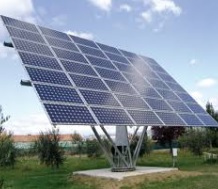 |
|
Photovoltaic
Solar
Power
Station |
| |
 |
|
Floating Photovoltaic
Solar
Power
Station |
| |
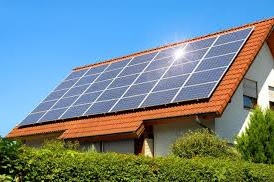 |
|
Photovoltaic
Solar
Power
Home |
|
|
|
|
* Note: Commercial Systems in UK: |
|
Let’s take a look at the smaller solar systems
available and their benefits in the UK:
-
A 4kw system will
need between 10 and 20 solar panels, with an initial cost of around
£7,000 for the module and installation. But over 20 years, the feed-in
payments and electricity savings you make could add up to around
£16,000. Plus government payments at the current tariff could get you
around £760 in savings and earnings per year.
* Calculations based on roof with 35 degree angle and South facing
with little or no shade. Most household roofs will be suitable for
a 4kW solar panel, though you will need 21m2 of roof
space
-
A 10kw system
will cost about £20,000 to purchase and install, and offers returns of
about £2,000 per year. That’s a great return rate for any business.
Quite large premises are required to install a system providing 10kW,
though it can provide the energy needs of many small businesses.
-
A 25kw system is
for you if your company has large energy demands, either due to the
nature of your work or the size of the operation. Typically warehouses
or other very large buildings are required to accommodate such a system.
They can cost in the region of £50,000 to install, but can still make
good financial sense for your company, as various businesses across the
UK have discovered.
|
|
|
| |
 |
ما هي تكلفة تركيب الطاقة الشمسية للمنازل؟ - لعام
2017
: | |
|
|
|
الطاقة الشمسية هي طاقة متجددة
ونظيفة.. ولكن ماذا عن
تكلفة التركيب؟
حينما نقول
طاقة شمسية فهذا يعني كل
التطبيقات المستخدمة لتحويل
هذه الطاقة إلى طاقة تولد الكهرباء وتحل بديلاً عنه
في تغذية مستلزمات الحاجات
اليومية.
فالطاقة الشمسية هي شكل من أشكال الطاقة
المتجددة والنظيفة، وهذا ما
جعلها تكسب صفة الأمان البيئي كونها لا تلوث الجو
كما أنّ التقنيات التي تستخدم
فيها تعدّ بسيطة مقارنة مع
مصادر طاقة أخرى.
وتساعد هذه الطاقة على تدفئة المنازل وتسخين
المياه كما بالإمكان
الاستفادة منها في تشغيل الأجهزة الكهربائية
البسيطة
|
 | |
| وبالعودة
إلى تركيب معدات الطاقة الشمسية فهناك
نوعان أساسيان من الألواح المستخدمة
وهما الألواح الأحادية ” مونو” والألواح المتعددة
الكريستالات “بولي” أمّا الفرق بينهما فهو أنّ
الألواح الأحادية تعمل بكفاءة أكبر في
المناطق الباردة مقارنة بالألواح
متعددة الكريستالات التي تعمل بكفاءة أكبر في المناطق
الحارة لذا هذا النوع يعتبر الاكثر
استخداماً في مناطق الدول العربية
ولحسن الحظ فإنّه أقل سعراً من نظيره .
وتترواح قدرة اللوح الواحد
الإنتاجية بين 100 و 350 وات، أما الألواح الأكثر
استخداماً فهي التي تنتج الـ 250 وات.
أما
سعر اللوح ذات قدرة 250 وات ومن نوع متعدد الكريستالات
فيترواح بين الـ130 دولار و200 دولار لكل
لوح شمسي إلاّ أنّ السعر قد يتفاوت
ويتبدل بحسب معايير أخرى ومنها نذكر
اسم الشركة المنتجة، وجودة الألواح وحتى ايضاً
شروط الضمان.
وهنا علينا أن نذكر أنّ 4 ألواح مجتمعة
يمكنها أن تولد واحد كيلو وات، لذا
فإنّ تكلفة واحد كيلو وات تتراوح بين 520 دولار
و 800 دولار
اما تكلفة الوات الواحد من الكهرباء في الطاقة
الشمسية فهو تقريباً 1.6 دولار وهذا
الرقم يتناقص مع التطور المستمر الذي
يحدث في هذا المجال.
في حين تكلفة الطاقة الشمسية لشقة
عادية فهي 200 كليلو وات أي تقريباً
2400 دولار، والجدير ذكره أنّ هذه التكلفة ليست بسيطة
إلاّ أنّها تدوم لمدة 20 سنة. أي انك كشخص
لن تدفع فاتورة
الكهرباء لمدة 20 سنة
إضافة إلى كون اسعار تجهيزات الطاقة الشمسية قد انخفضت
من 6000 دولار إلى 1500
دولار.
اضف ان هذه
التكلفة بتناقص مع التطور المستمر الذي
يحدث في مجالهذه
الصناعة . |
|
|
|
|
|
| | | |
|
| |
|
|
|
|
|
|
|
|
|
|
| |
| |
|
|
2- Download, Electrical Installation
Course in French |
Cours d'Installation des
reseau Electrique, en
Français |
|
|
|
Cours d'Installation des
reseau Electrique, en
Français : |
French text
-
290 KB zip
file
download |
|
| |
-
Installation
Electrique, Montage Lumiere, Les Titles
-
Prise de
Courant
-
Simple
Allumage
-
Double
Allumage
-
Selection de
2 Circuits
- Le
Va
-et-Vient
-
Permutateur
-
Telerupteur
|
- Ce Cours des
infos, plans electrics
...
- Texte en Français, file
type
HTML
|
|
|
|
|
|
|
| |
| |
| |
|
3-
Download Study, Produce of Gas from
the scrap, in English &
French & Arabic |
|
|
|
|
|
the
Description of this Study : |
| |
- The steps
to
produce and
assemble the
gasfrom the solid Scraps(human, animal
or other).
- The
fermentation of
the solidscraps can cause the
production of the gas .
- The gas stocked in the tank
to be use to
produce the electricity,
to heat,
or
,,,
- A diagram summarize the
operation of the
production of the gas.
- English text,
HTML file.
|
|
|
|
|
|
|
la
Description de cette Etude : |
| |
- Les
etapes pour produire et
assembler le gazdes
dechets solides
(humains, animals ou
...).
- La
fermentation
des dechets
solides causera la production du
gaz.
- Le gaz
stocké dans le réservoir
s'utilise dans la production
d'electricite, dans le
réchauffement, ou ,,,
- Un
schèma resume
l'operation de production du
gaz.
- Texte en Français, file type
HTML
|
|
|
|
|
|
|
|
|
|
|
|
|
| |
| |
| www.puresoftwarecode.com
: |
|
HUMANITIES
Institute |
ART Institute
& Others |
| SOFTWARE
Institute |
CHRISTIANITY
Institute |
|
|
|
"Free, 100 Software
Programming Training Courses"
|
|
Le
HANDICAP c'est quoi ? (in French) |
Basilica
Architecture, in the Shape of a Cross |
| VISUAL STUDIO 2010 in
English |
Holy BIBLE in 22 Languages and Studies
... |
Drugs and Treatment in English, french,
Arabic |
Old Traditional Lebanese
houses |
| VISUAL STUDIO .NET, Windows & ASP in
English |
220 Holy Christian
ICONS |
Classification of Wastes from the Source
in Arabic |
5 DRAWING Courses & 3 Galleries |
| VISUAL STUDIO 6.0 in
English |
Catholic Syrian MARONITE Church
|
|
Meteora,
Christianity Monasteries - En, Ar, Fr |
| Microsoft ACCESS in
English |
HOLY MASS of Maronite Church - Audio
in Arabic |
Christianity in the Arabian Peninsula in
Arabic |
Monasteries of Mount Athos & Pilgrimage |
| PHP & MySQL in
English |
VIRGIN MARY, Mother of JESUS CHRIST
GOD |
Summary of the Lebanese history in
Arabic |
Carved
Rock Churches, in Lalibela, Ethiopia |
| SOFTWARE GAMES in
English |
SAINTS of the Church |
LEBANON EVENTS 1840 & 1860, in
Arabic |
|
| WEB DESIGN in English |
Saint SHARBEL - Sharbelogy in 10
languages, Books |
Great FAMINE in LEBANON 1916, in
Arabic |
my PRODUCTS, and Statistiques ... |
| JAVA SCRIPT in
English |
Catholic RADIO in Arabic, Sawt el
Rab |
Great FAMINE and Germny Role 1916,
in Arabic |
|
| FLASH - ANIMATION in
English |
Читать -
БИБЛИЯ и Шарбэль cвятой, in Russe |
Armenian Genocide 1915 in
Arabic |
4 Different
STUDIES |
| PLAY, 5 GAMES |
|
Sayfo or Assyrian Genocide 1915 in
Arabic |
SOLAR Energy & Gas
Studies |
| |
|
Christianity in Turkey in
Arabic |
WELCOME to LEBANON |
| SAADEH BEJJANE
Architecture |
|
|
YAHCHOUCH, my Lebanese
Village |
| |
|
Prononce English and French and Arabic
Letters |
ZOUEIN, my Family - History &
Trees | |
|
|
| |